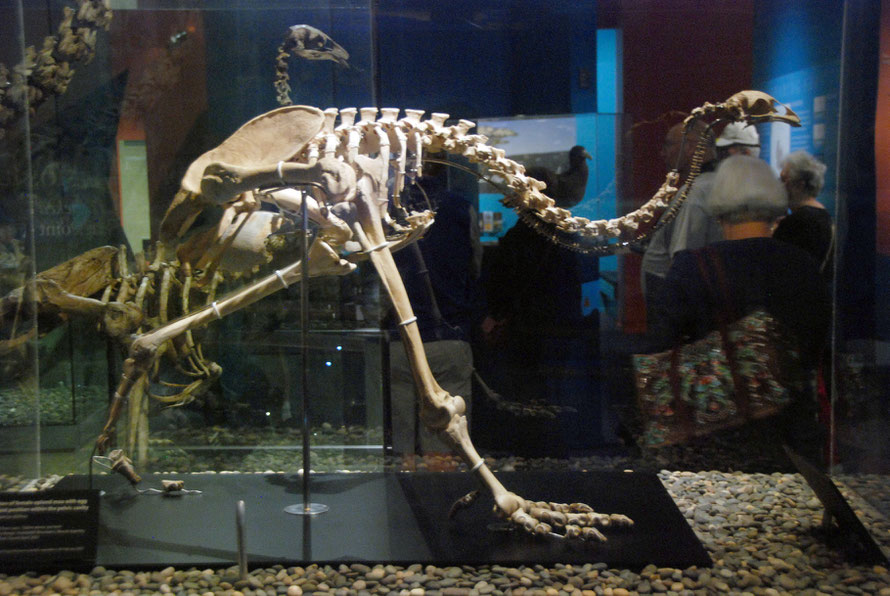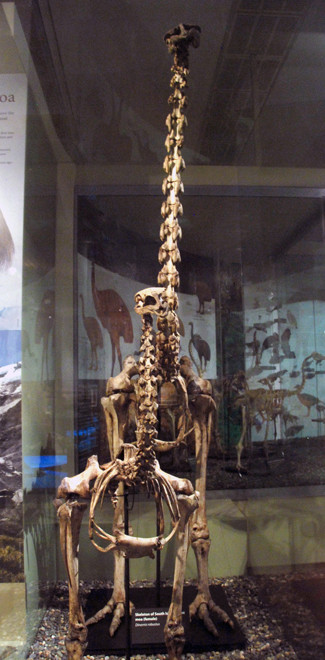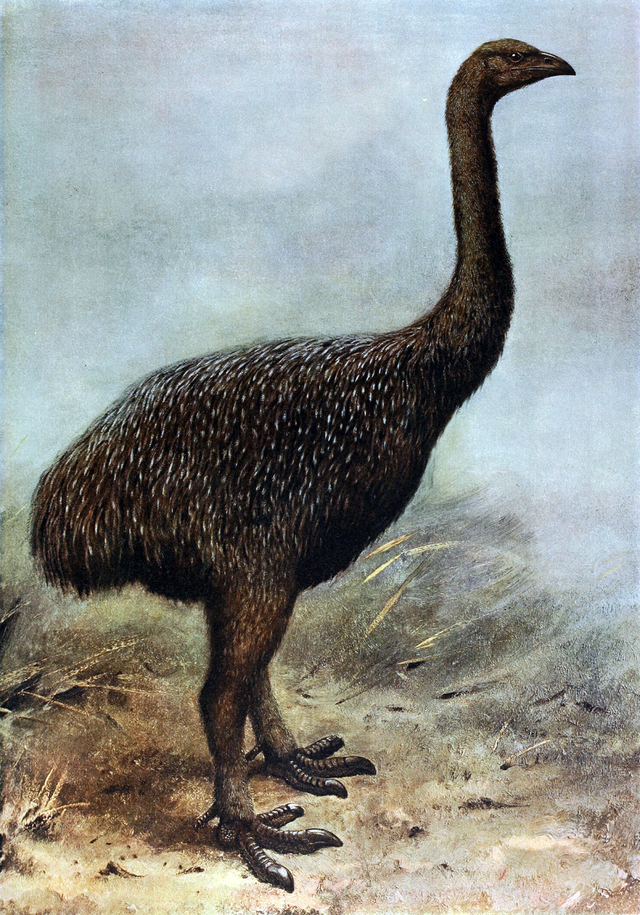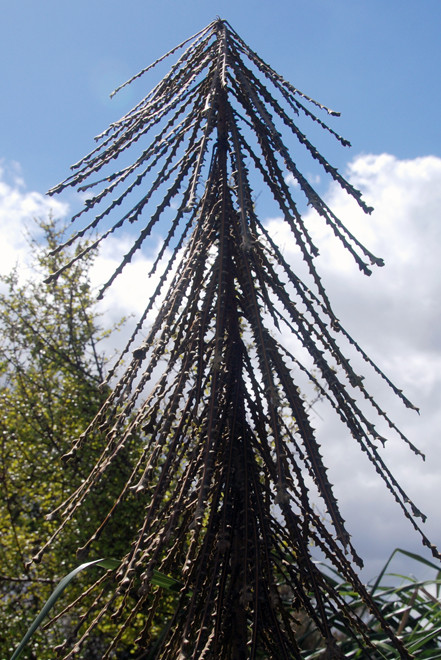New Zealand's Unique Biota: the example of the Moa
One of the most striking, if not the most striking, aspects of New Zealand is its absolutely unique evolutionary course and its resulting biota - plants, animals, fungi and micro-organsims of which there are some 55,000 known species.
I wanted in some way to pay tribute to this fact in these pages about New Zealand. But that is a big ask, particularly when there is the excellent book by George Gibbs, Ghosts of Gondwana, that explores and summaries the evidence of this phenomena and the different aspects of its development in such brilliant depth and with such scientific prudence.
To put it at its most striking the evolution of New Zealand's unique biota (52% of the country's species are endemic to New Zealand) was an '80-million-year experiment ... without mammals'
(George Gibbs, personal communication).
Apart from a bat and sea-living mammals there were no mammals in New Zealand until humans (who only arrived in 1200-1300 AD) introduced them. Since its separation from the Gondwana super-continent 80 million years ago New Zealand has been on its own as it has gradually drifted further out into the vastness of the Pacific Ocean.
Rather than poorly rehashing the outlines of this amazing development and the linkages with other southern hemisphere countries such as South Africa, Australia, Chile and Antarctica, all of which formed part of Gondwana, I have here opted to look at one aspect of this process. That is existence of the many species of the giant, flightless and abundant Moa that took the place of large mammals in New Zealand's mammal-free evolution.
The vulnerability of this unique ecosystem and its high levels of diversity and endemism was dramatically illustrated by the extinction of the Moa within 500 years of the arrival of humans and the predators that they introduced.
That vulnerability continues to this day with the loss of 70% of New Zealand's original habitat and the huge problems created by the introduction of a wide range of animals and plants for which there are not natural predators (see in particular here the controversy that rages over the widespread air-dropping of pelleted 1080 poison across vast tracts of New Zealand's remaining indigenous vegetation - my page on 1080 is here).

The strange and wonderful Moas once dominated New Zealand from tip to toe. The biggest birds in the world by height they were abundant and found from the coastal flats to 2000m up in the Southern Alps.
Moa were the dominant New Zealand land vertebrates, 'exhibiting far greater adaptive radiation than other New Zealand land birds.' This was greatest in the South Island and seems to have been associated with the diverse habitat creation of mountain building 5-8.5 MYA (NZ Birds Online).
They were hunted to extinction within a few hundred years of the arrival of New Zealand's Polynesian settlers (with the help of habitat loss and the introduction of predators, particularly the Polynesian dog or kuri).
The page starts by considering two hypotheses regarding the co-evolutionary role of the vanished Moa.
The first is the so-called (and much criticised) 'Future Eaters' theory put forward by Australian Tim Flannery in the 1990s.
The second is the more specific theory of the co-evolutionary linkage between Moa grazing and the development of divaricate (many-branched and many-growing-point plants) in New Zealand summarised by George Gibbbs in his wonderful, Ghosts of Gondwana.
The last part of the page has a quick look (with photos and bones) at three of the Moa species, the Giant, the Upland and the Little Bush Moas.

The Future Eaters
I have been reading The Future Eaters: an Ecological History of the Australasian Lands and People (1994) by Tim Flannery (See the useful Wikipedia page on his work and life - he was voted Australian of the Year in 2007 for his book on climate change, The Weather Makers: The History & Future Impact of Climate Change.)
The Future Eaters makes for fascinating and provocative reading. (It was made into a TV series by the Australian Broadcasting Corp and there is a very useful website with episode transcripts and a range of critics' responses to each episode.)
Flannery's thesis argues that the hunting down of the mega-mammals and birds by ancient societies in Australasia has led to profound changes in both habitats and the management of the land. So for example, in Australia he argues that the probable hunting to extinction of now extinct mega-mammals in Australia led to:
- a huge accumulation of dead and dying vegetable matter that was once eaten by the mega-herbivores. This fuelled increasingly destructive forest fires that burned more intensely and ranged more widely than previously;
- a shift in Aboriginal fire management with the use of 'firestick farming' where small fires were deliberately set to:
a) stop the accumulation of mountains of tinder once eaten by the giant herbivores and thus protect the remnant forests from devastating fires;
b) keep the vegetation sweet for the remaining medium-sized mammals that became a staple of Aboriginal diet - rather like an English or Scottish grouse moor being burnt off in controlled patches and strips so that there are always new heather tips growing for the grouse to eat.

He argues that in New Zealand the existence of moa as a source of easy to capture protein led to a rapid rise in the population of early Maoris in New Zealand. Then as moa became increasingly scarce Maori hunters became forest burners as their protein needs were increasingly met by either bracken fern roots or the tubers of the cordyline tree (Cabbage Tree).
(An additional depletion of protein stocks was caused by the introduction of predators of small birds - the kiore - Polynesian rat, or Pacific rat (Rattus exulans) and dogs (Polynesian dog - kuri) and pigs.)
While the burning of the forests made a kind of survivalist sense it was ruinous for the forest soils whose scarce nutrient store was soon leached and washed down to the coastal and valley flats.
This may have increased the fertility of these and pushed Maori habitation towards them but at the same time the available protein resource diminished drastically with the extinction of the moa.
Flannery goes on to argue that this in turn led to increasing hostility between Maori iwi and villages as the search for and protection of protein became increasingly insecure. This in turn led to warfare and a ritualised cannibalism that was actually a response to the disappearance of the moa.

Criticism of the Future Eater hypothesis
Flannery's critics argue with regard to the Australian hypothesis that there is little compelling evidence to link the extinction of megafauna with Aboriginal hunting. It more likely occurred due to climate change and the cooling related to the Ice Ages. If this is the case the devastating fires may have stopped due to changes in vegetation - from forest to grassland in essence.
With regard to the New Zealand thesis above James Belich, one of the critics from the ABC TV panel of critics says,
What I think you had was a change in food gathering techniques, ... towards [the] sustainable management of natural resources ... a shift [occurs] towards seafood, shellfish, ocean fish, and ... the development of quite sophisticated techniques that were somewhere between gardening and gathering. There's an increased use of Tapu, and Rahui, sacred prescriptions to prevent the taking of vulnerable resources outside the appropriate times ... [there is a] shift from a few big easy targets to many, small difficult targets and from extracted economics to sustainable economics.
He and the other critics argue that the shift from Moa protein to other forms of protein were not as dramatic as Flannery makes out. There was a gradual continuum of replacement. They further argue that cannabalism was ritualistic and took place within a culture where the supernatural power of enemies had to be neutralised and that warfare was more about protecting food resources than killing people to eat and was in any case a hugely expensive expenditure of energy for people who were possibly suffering protein deficiency.
Flannery clearly has an eye for the big synthetic picture and at some point discovered that painting with a big brush can pull in the crowds. Nevertheless his work is serious enough to be taken seriously.

Co-evolutionary approaches: Ghosts of Gondwana
George Gibbs is a much more circumspect biogeographer than Flannery. He argues that moa in New Zealand filled the evolutionary space of gazelles in Africa and kangaroos in Australia.
The moa ranged virtually everywhere and spent hours each day picking leaves, twigs, fruits and seed off low lying trees and shrubs (low is relative - the giant moa could reach up to 3.6m). Moa particularly favoured forest edges, wetlands and fertile valley bottoms.
There were 14 species of Moa ranging from the turkey-sized (at 20kgs says Gibbs although that is a pretty huge turkey) to the giant Moa (Dinornis robustus) whose females weighed in at 250kg.
Moa date back at least 4 million years and fossil records from the Holocene (10,000 years ago) suggests they were 'remarkably abundant'.

The co-evolution of Moas and the plants they fed on is coloured by the particular way that birds feed as opposed to mammalian herbivores. Birds have strong colour vision, a poor sense of smell (although others have suggested that the large nasal cavity in the giant moa might have been a sign of a keen sense of smell), hard beaks, and no versatile tongue.
They are immune to thorns and rely on plucking rather than grasping with the tongue and lips to take in food. The Moa beak was like a secateur and some species 'had no trouble snipping through twigs up to 15 millimetres in diameter' (p. 163).
In the late 1970s a hypothesis emerged that suggested that the particular form of many New Zealand trees and shrubs - divarication - might be a result of co-evolution with the Moa.
Divaricates have small leaves, lots of small tangled branches, tough wiry stems and many internal growing points. Further, some tree species such as the Matai (see photos) have a young state as a divaricate before developing a central growing point out of the reach of Moa predation.

Divaricates make up 10% of all woody plant life in New Zealand and occur in 17 different plant families. Gibbs is pretty convinced by the evidence that there is a direct relationship between the predominance of divaricates in New Zealand and the particular grazing habits of the abundant and widespread moa (which have feeding habits quite different from other ratites like the emu and ostrich which graze on grasses). Climate may have accelerated this process of co-evolution as the Ice Ages favoured plants that could withstand abrasion and frost damage.
Other New Zealand plants also show a remarkable juvenile forms - for example the lancewood with its tough, brown, strong leaves (they are known as 'wire plants' in Australia). In mature form when out of reach of grazing the leaves become greener and less wirelike.
Source: for above see Gibbs, Ghost of Gondwana pp.161-6

Possum and Deer
The introduction of possum - tree-top dwelling omnivores - and red and white-tailed deer into New Zealand in the 19th century - completely changed the threat posed to plants by herbivores.
Whereas thorns were not much use against the Moa with their insensate beaks and were distinctly lacking in New Zealand's flora their absence now made plants vulnerable to deer-grazing where thorns were a well-developed co-evolutionary response in other continents.
And possum simply by-passed the divaricates by climbing into the canopy cover and feasting on the unprotected growing tips and young leaves there.

The Upland Moa (Megalapteryx didinus)
The Upland Moa stood at one metre high, weighed about 56kg and held its head slightly above the level of its back like a modern day Cassowarie. They had no wing or wing traces at all and, like other Moa, are unique in birds in this regard.
The perfect skeleton in the photograph above was found in limestone caves near Karamea in 1987. It is estimated to be 15,000 years old.
Moa are remarkable birds with long necks, a sternum with no keel because they had no wings, three-boned legs with a massive short thigh bone and huge feet with one rear facing and three front facing toes.
The Upland Moa inhabited the subalpine zone up to 2,000m in the South Island and was more agile than the larger moa. It had uniquely feathered lower legs and a mottled appearance.

The Giant Moa (Dinornis novaezealandiae and D. robustus)
Although from the family of ratites like ostrich and emu Moa are thought to have branched off the family tree earliest and have no close relatives.
The biggest was the Giant Moa which stood two metres up to the top of its back and weighed 250kg - the same as a cow. They could reach between 3m and 3.6m depending on who you believe and were the tallest birds the world has ever seen (although not the heaviest - that record is held by the extinct Madagascan elephant bird). For good measure, they had three extra vertebrae in their massive necks.
The birds probably had reddish-brown, shaggy, hair-like feathers. Eggs weighed about 4kg and were incubated for two months by the males - as in other ratite species.

DNA studies have revealed that in the Giant Moa there was extreme sexual dimorphism (size difference between the sexes). The females could be more than twice as big as the males. DNA studies also suggest that Moa were more closely related to the flighted South American tinamou than to the kiwi.
All Moa had been hunted to extinction by 1400-1500. It is thought Moa in general grew very slowly, taking up to 10 years to reach adult size. This would have made them particularly vulnerable to human predation (see Natural History Museum).
There were two species of the Giant Moa - the North Island D. novaezealandiae and the South Island D. robustus.
Moa were the dominant New Zealand land vertebrates, 'exhibiting far greater adaptive radiation than other New Zealand landbirds.' This was greatest in the South Island and seems to have been
associated with the diverse habitat creation of mountain building 5-8.5 MYA (NZ Birds Online).
In the 1930s excavations near the Waitaki river mouth revealed 1,200 moa ovens and middens and the remains of between 29,000 to 90,000 birds.
The Little or Small Bush Moa (Anomalopteryx didiformis)
The little bush moa was the smallest and most widespread moa species, occurring in dense forest and shrubland throughout the North and South Islands. The short, sharp-edged bill and large number of stones found in the bird's gizzard suggest that it had a woody, fibrous diet.
It may have lived singly at a density of one pair per square kilometre and was probably preyed on by the extinct Haast's eagle and Eyles' harrier in the South Island.

(Sources for Moa texts: Wikipedia, NZ Birds Online, New Zealand National Museum, Wellington and Auckland Museum. All photos my own unless stated.)


To finish this page here is video about the far-reaching impact of the reintroduction of wolves in the Yellowstone National Park in the USA. Its narrated by George Monbiot and from an organsition called Sustainable Human and talks about this impact as a 'trophic cascade'.
Were the Haast Eagle still extant it would surely be a better way of reasserting a natural predator in New Zealand's depleted and skewed endemic and introduced fauna than by the airdropping of 1080 poison over vast areas?
Thanks to Peter Tait on Ulva Island for pointing out the video.




